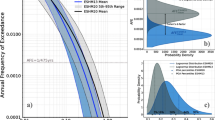Abstract
We tested a new hybrid method for the evaluation of seismic hazard. A recently proposed fault segmentation and earthquake recurrence model of peninsular Italy suggests that the interval for which the local historical catalogue is complete is shorter than the mean recurrence time of individual large faults (∼1000 years), or at the most comparable. These new findings violate the fundamental assumption of historical probabilistic seismic hazard methods that the historical record is representative of the activity of all the seismogenic sources. The hybrid method we propose uses time-dependent modelling of the major earthquakes and catalogue-based historical probabilistic estimates for all minor events. We assume that the largest earthquakes are characteristic for individual discrete fault segments, model their probability of occurrence by a renewal process and compute the shaking associated with each of them with a simplified procedure. Then we calculate the probability of exceeding a given threshold of peak ground acceleration for specific sites as the aggregate probability of occurrence of large characteristic earthquakes and minor shocks. We apply the method to the Calabrian Arc (Southern Italy) performing the calculations for five major towns. The exposure to seismic hazard of Reggio Calabria, Catanzaro and Vibo Valentia, which locate close to recently activated large faults, decreases with respect to traditional time-independent estimates. On the contrary, an increase of seismic hazard is obtained for Castrovillari, which locates in an area where large faults displaying Holocene activity have been recently recognized but no significant earthquake is reported in the historical catalogue. Cosenza has the highest probability to experience a significant peak ground acceleration with both the new hybrid and the traditional approaches. We wish to stress that the present results should be interpreted only in terms of the differences between the new hybrid and the traditional approaches, not for their absolute values, and that they are not intended to be used for updating or modifying the current national seismic zonation.
Similar content being viewed by others
References
Boschi, E., Ferrari, G., Gasperini, P., Guidoboni, E., Smriglio, G., and Valensise, G. (eds.): 1995, Catalogo dei forti terremoti in Italia dal 461 a.C. al 1980, ING and SGA, Bologna, 973 pp.
Boschi, E., Giardini, D., Pantosti, D., Valensise, G., Arrowsmith, R., Basham, P., Bürgmann, R., Crone, A., Hull, A., McGuire, R., Schwartz, D., Sieh, K., Ward, S., and Yeats, R.: 1996, New trends in active faulting studies for seismic hazard assessment, Consensus statement of the XI Course of the International School on Solid Earth Geophysics ‘Active Faulting Studies for Seismic Hazard Assessment’, Annali Geof. 39, 1301–1307.
Cinti, F. R., Cucci, L., Pantosti, D., D'Addezio, G., and Meghraoui, M.: 1996, A major seismogenic fault in a ‘silent area’. The Castrovillari fault (Southern Apennines, Italy), Geophys. J. Int., in press.
Gumbel, E. J.: 1958, Statistics of Extremes, Columbia Univ. Press, New York, 375 pp.
Margottini, C., Molin, D., and Serva, L.: 1992, Intensity versus ground motion: a new approach using Italian data, Engineering Geology 33, 45–88.
McGuire, R. K. (ed.): 1993, The Practice of Earthquake Hazard Assessment, IASPEI, Denver, 284 pp.
Muir-Wood, R.: 1993, From global seismotectonics to global seismic hazard, Ann. Geofis. 36, 153–168.
Pantosti, D. and Valensise, G.: 1988, La faglia sud-appenninica: identificazione oggettiva di un lineamento sismogenetico nell'Appennino meridionale, in: Atti del VII Convegno G.N.G.T.S., Esagrafica, Roma, pp. 205–220.
Pantosti, D. and Valensise, G.: 1995, Investigating active faulting in Italy, in: G. Valensise and D. Pantosti (eds.), Proc. Conference on Active Faulting Studies for Seismic Hazard Assessment, Erice, 27 Sept.–5 Oct. 1995.
Pantosti, D., D'Addezio, G., and Cinti, F. R.: 1996, Paleoseismicity of the Ovindoli-Pezza fault (Central Italy): a history including a large, previously unrecorded earthquake in Middle Ages (890–1300 AD), J. Geophys. Res., 101, 5937–5959.
Postpischl, D. (ed.): 1985, Catalogo dei terremoti italiani dal 1000 al 1980, Quaderni della ricerca scientifica, 114, 2B.
Sabetta, F. and Pugliese, A.: 1987, Attenuation of peak horizontal acceleration and velocity from Italian strong-motion records, Bull. Seism. Soc. Am. 77, 1491–1513.
Schwartz, D. P. and Coppersmith, K. J.: 1984, Fault behavior and characteristic earthquakes: examples from the Wasatch and San Andreas Fault Zones, J. Geophys. Res. 89, 5681–5698.
Valensise, G. and Guidoboni, E.: 1995, Verso nuove strategie di ricerca: zone sismogenetiche silenti o silenzio delle fonti? in: E. Boschi, G. Ferrari, P. Gasperini, E. Guidoboni, G. Smriglio and G. Valensise (eds.), Catalogo dei forti terremoti in Italia dal 461 a.C. al 1980, ING and SGA, Bologna, pp. 112–127.
Wells, D. L. and Coppersmith, K. J.: 1994, New empirical relationship among magnitude, rupture length, rupture width, rupture area, and surface displacement, Bull. Seism. Soc. Am. 84, 974–1002.
Westaway, R.: 1992, Seismic moment summation for historical earthquakes in Italy: tectonic implications, J. Geophys. Res. 97, 15437–15464.
Working Group on California Earthquake Probabilities: 1990, Probabilities of Large Earthquakes in the San Francisco Bay Region, California, U.S. Geological Survey, Circular 1053, 51 pp.
Working Group on California Earthquake Probabilities: 1995, Seismic hazards in southern California: probable earthquakes, 1994–2024. Bull. Seism. Soc. Am. 85, 379–439.
Wu, S. C., Cornell, C. A., and Winterstein, S. R.: 1995, A hybrid recurrence model and its implication on seismic hazard results, Bull. Seism. Soc. Am. 85, 1–16.
Author information
Authors and Affiliations
Rights and permissions
About this article
Cite this article
Peruzza, L., Pantosti, D., Slejko, D. et al. Testing a new hybrid approach to seismic hazard assessment: an application to the Calabrian Arc (Southern Italy). Nat Hazards 14, 113–126 (1996). https://doi.org/10.1007/BF00128260
Received:
Revised:
Issue Date:
DOI: https://doi.org/10.1007/BF00128260




